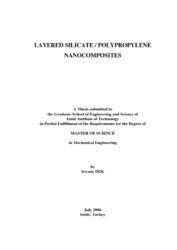Please use this identifier to cite or link to this item:
https://hdl.handle.net/11147/3219Full metadata record
| DC Field | Value | Language |
|---|---|---|
| dc.contributor.advisor | Tanoğlu, Metin | en |
| dc.contributor.author | Işık, Kıvanç | - |
| dc.date.accessioned | 2014-07-22T13:51:06Z | - |
| dc.date.available | 2014-07-22T13:51:06Z | - |
| dc.date.issued | 2006 | en |
| dc.identifier.uri | http://hdl.handle.net/11147/3219 | - |
| dc.description | Thesis (Master)--Izmir Institute of Technology, Mechanical Engineering, Izmir, 2006 | en |
| dc.description | Includes bibliographical references (leaves: 76-80) | en |
| dc.description | Text in English; Abstract: Turkish and English | en |
| dc.description | xi, 80 leaves | en |
| dc.description.abstract | Layered silicate nanocomposites are new generation materials that have unique properties obtained by low particulate loadings. In this study, layered silicate/polypropylene nanocomposites were prepared by melt intercalation method.Homopolymer PP alone and maleic anhydride-grafted polypropylene (PPgMA) as a compatibilizer were used as the matrix. Clay (Na+ montmorillonite, MMT) particles were used with and without structural modification to obtain silicate nano-layers within the PP matrix. Structural modification of MMT using hexadecyltrimethyl ammonium chloride (HTAC) was applied to obtain organophilic silicates (OMMT). XRD results demonstrated that the dispersion of the modified silicate layers and compatibilized with PPgMA (OMMT/PPgMA) is better than those for incompatibilized compositions. The addition of silicate layers increased the crystallization temperature of PP as well as the thermal stability, but the melting temperature of the nanocomposites was decreased by the addition of silicate as compared with neat PP. The mechanical characterizations exhibited an increase of 62% on tensile modulus and 15% on tensile stress at break as compared to neat PP due to the improved dispersion of silicate layers within PP in 3 wt.% OMMT/PPgMA/PP nanocomposites. The effect of clay modification and PPgMA compatibilization on the light transmission of PP nanocomposites was characterized by optical transmission analysis. For the OMMT/PPgMA/PP nanocomposites, light transmission was improved as the dispersion was enhanced. The flammability results demonstrated that unmodified MMT and modified OMMT decreased the burning rate of PP nanocomposites. The organic modification of clay and compatibilization decreased the rate of flammability. A decrease of 26% on the burning rate of PP was recorded in 10%wt. OMMT/PPgMA/PP nanocomposites. | en |
| dc.language.iso | en | en_US |
| dc.publisher | Izmir Institute of Technology | en |
| dc.rights | info:eu-repo/semantics/openAccess | en_US |
| dc.subject.lcc | TA418.9.N35 .I81 2006 | en |
| dc.subject.lcsh | Nanostructured materials | en |
| dc.subject.lcsh | Polymeric composites | en |
| dc.title | Layered silicate / polypropylene nanocomposites | en_US |
| dc.type | Master Thesis | en_US |
| dc.institutionauthor | Işık, Kıvanç | - |
| dc.department | Thesis (Master)--İzmir Institute of Technology, Mechanical Engineering | en_US |
| dc.relation.publicationcategory | Tez | en_US |
| item.grantfulltext | open | - |
| item.openairecristype | http://purl.org/coar/resource_type/c_18cf | - |
| item.cerifentitytype | Publications | - |
| item.openairetype | Master Thesis | - |
| item.languageiso639-1 | en | - |
| item.fulltext | With Fulltext | - |
| Appears in Collections: | Master Degree / Yüksek Lisans Tezleri | |
Files in This Item:
| File | Description | Size | Format | |
|---|---|---|---|---|
| T000532.pdf | MasterThesis | 4.6 MB | Adobe PDF |  View/Open |
CORE Recommender
Page view(s)
90
checked on Apr 22, 2024
Download(s)
50
checked on Apr 22, 2024
Google ScholarTM
Check
Items in GCRIS Repository are protected by copyright, with all rights reserved, unless otherwise indicated.